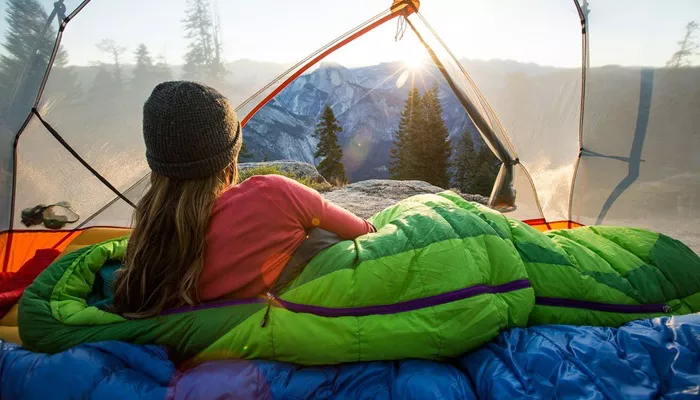Sleeping bag season refers to the time of year when temperatures drop low enough to require proper insulation for comfortable sleep outdoors. As an experienced camper, I know choosing the right sleeping bag makes all the difference between restful nights and miserable shivering.
Manufacturers rate sleeping bags by “season” to help outdoor enthusiasts pick appropriate gear. This system classifies bags based on their temperature ratings and intended use during different times of year. The concept originated in Europe but has become a global standard.
The Four-Season Classification System
1-Season Sleeping Bags (Summer Use)
These lightweight bags work for warm weather camping when nighttime temperatures stay above 50°F (10°C). They prioritize breathability over insulation, often featuring:
- Thin synthetic or down fill (about 1-1.5 inches loft)
- Minimal hood construction
- Lightweight shell materials
- Half or 3/4 length zippers
Perfect for music festivals, beach camping, or summer backpacking trips where pack size matters more than warmth.
2-Season Sleeping Bags (Late Spring to Early Fall)
Designed for temperatures between 40-50°F (4-10°C), these transitional bags offer:
- Moderate insulation (2-3 inches loft)
- Basic hood designs
- Full-length zippers
- Either down or synthetic fills
I recommend these for most summer camping in mountainous regions or for sleepers who tend to get cold easily.
3-Season Sleeping Bags (Fall to Early Winter)
When autumn colors appear and temperatures dip to 20-40°F (-7 to 4°C), serious campers switch to 3-season bags featuring:
- 4-5 inches of loft
- Insulated hoods with draft collars
- Draft tubes along zippers
- Higher fill power down or premium synthetics
These work well for most camping situations outside extreme winter conditions.
4-Season Sleeping Bags (Winter and Alpine Use)
Built for temperatures below 20°F (-7°C), these expedition-grade bags include:
- 5+ inches of loft
- Expedition hoods with face apertures
- Extra width for layering clothes
- Water-resistant shell fabrics
- Often mummy-shaped to maximize heat retention
Essential for winter camping, high-altitude mountaineering, or Arctic expeditions.
Beyond the Numbers: Real-World Considerations
While season ratings provide helpful guidelines, several factors influence actual performance:
Sleeping Pad R-Value: Insulation beneath you matters as much as what’s above. Pair your bag with an appropriate pad.
Humidity and Wind: Damp conditions or breezes can make bags feel colder than their ratings suggest.
Metabolism Differences: Women generally need bags rated 10-15°F warmer than men for equivalent comfort.
Age and Health: Older campers or those with circulation issues should choose warmer bags.
Material Choices: Down vs. Synthetic
Down Insulation
- Lightweight and highly compressible
- Excellent warmth-to-weight ratio
- Loses insulation when wet
- Requires careful maintenance
- Higher cost
Synthetic Insulation
- Performs better when damp
- Easier to clean and maintain
- Bulkier and heavier
- More affordable
- Dries faster
For most 3-season camping, I prefer high-quality down bags. But synthetic works better in consistently wet environments.
Specialized Sleeping Bag Types
Double Bags
Two-person designs combine for extra warmth through shared body heat – great for couples winter camping.
Quilt-Style Bags
These minimalist designs eliminate zippers and hoods to save weight for ultralight backpackers.
Rectangular vs. Mummy Shapes
Rectangular bags offer more room but less efficient warmth retention than form-fitting mummy designs.
Caring for Your Investment
Proper maintenance extends your sleeping bag’s life:
- Always store uncompressed in a breathable cotton sack
- Spot clean when possible
- Use technical detergents for machine washing
- Dry thoroughly before storage
- Avoid excessive compression during transport
Regional Seasonal Variations
Sleeping bag needs vary by location:
Desert Camping: Wide temperature swings may require layering systems rather than a single bag.
Tropical Environments: A lightweight bag liner often suffices instead of a full sleeping bag.
Mountain Expeditions: Altitude dramatically affects temperatures, requiring careful season selection.
Transitioning Between Seasons
Smart campers layer systems:
- Add a liner to extend a bag’s range
- Use a bivy sack for wind/water protection
- Wear appropriate sleep clothing
- Combine quilts with sleeping bags in extreme cold
Common Mistakes to Avoid
- Choosing a bag rated too cold for actual conditions
- Overlooking the importance of a proper sleeping pad
- Storing bags compressed for long periods
- Assuming all “4-season” bags work for extreme winter
- Neglecting to test gear before extended trips
The Future of Sleeping Bag Technology
Innovations continue to improve performance:
- New hydrophobic down treatments resist moisture
- Advanced synthetic fibers mimic down’s properties
- Integrated heating systems (battery-powered)
- Smart fabrics that adjust insulation dynamically
Conclusion
Understanding sleeping bag seasons helps outdoor enthusiasts stay comfortable in nature’s changing conditions. While the rating system provides a helpful framework, personal factors and trip specifics ultimately determine the ideal choice. By selecting appropriate seasonal gear and using it properly, campers can enjoy restful sleep in any environment.
Related topics:
Is a 2000mm Waterproof Tent Good? A Complete Guide
Sleeping Bag Deals: Meet Cost-effective Sleeping Bags
Best Double Sleeping Bags: A Comprehensive Guide

